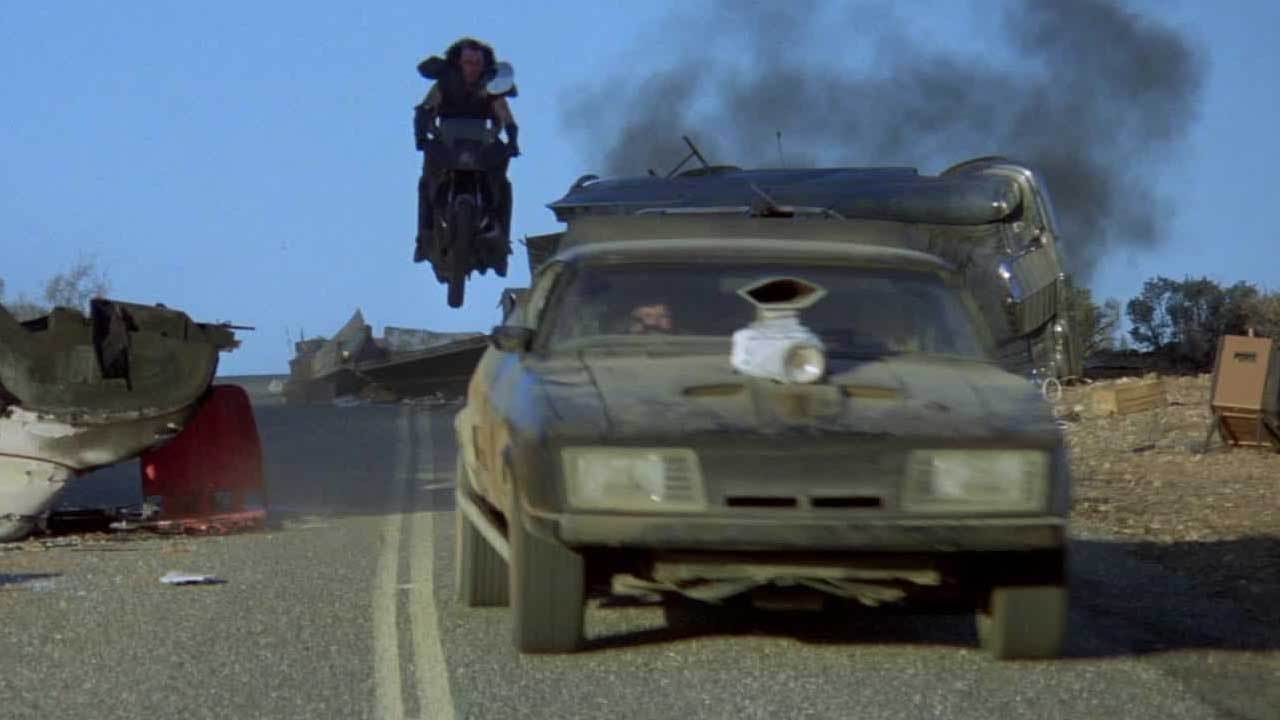20 Movies: The Road Warrior
"On the road, it was a white line nightmare."
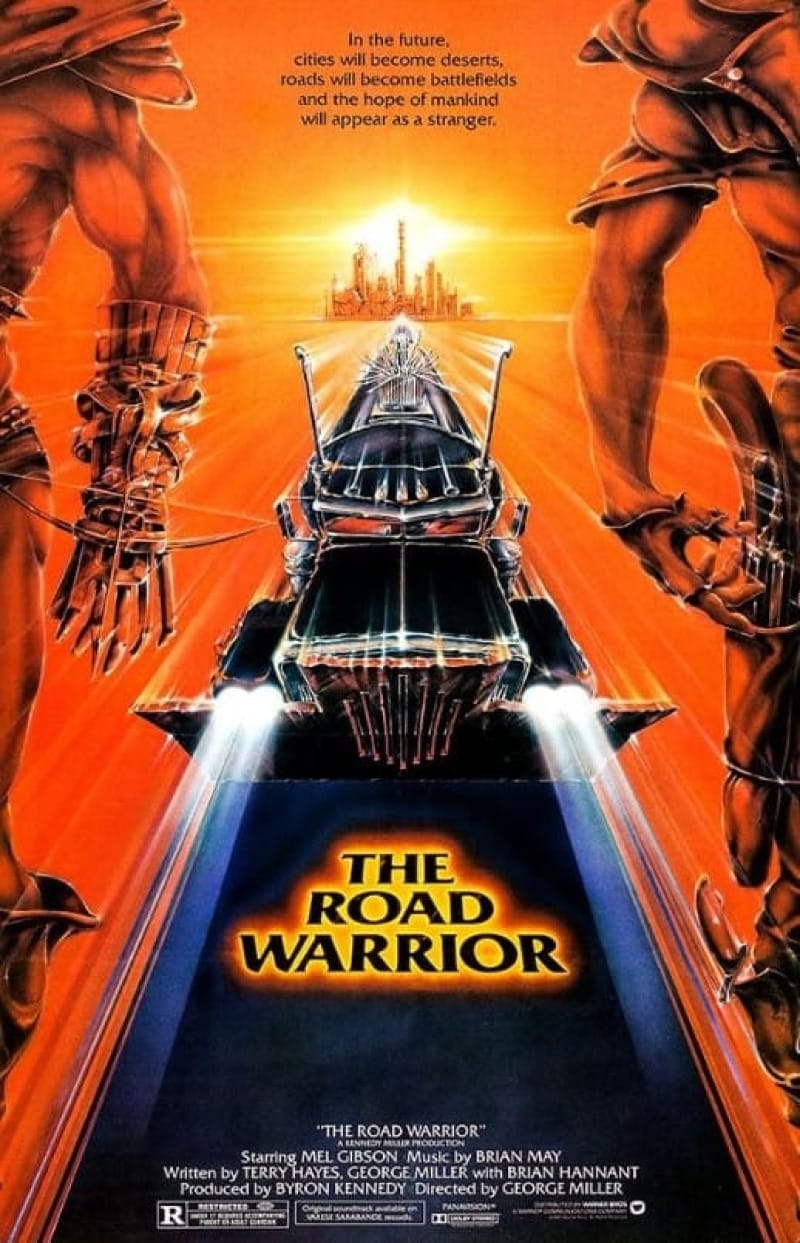
As the World slowly collapsed, Max Rockatansky’s wife and infant son were murdered, run down by outlaw bikers. After avenging their deaths, he drove off into the wasteland to die. But in the time since, despite living in a constant state of high-octane road war against the scavengers who hunt the sun-baked highways, he yet still lives, always driving, searching for gas, scavenging in the ruins of the old world. It is only when Max finds a peaceful community, threatened by a horde of nomadic post-apocalyptic barbarians, that he finds a reason to keep going.
I'm posting about 20 specific movies because of a social media trend-game. The idea was that you choose 20 movies that greatly influenced you, and then you post the poster of each one, one per day, for 20 days. No reviews, no explanations, just the posters. So, I’m doing that.
But I also wanted to talk about them a little bit...

As I’ve mentioned before, my main interests when it comes to genre fiction, and my main influences when it comes to my own fiction, can all ultimately be traced back to a very early exposure to the creative endeavors of “Three Georges, a Stan, and a Stephen,” and among those three Georges, besides Lucas and Romero, is the writer and director of The Roadwarrior, George Miller. (The Stan is Stan Lee, of course, and the Stephen is Stephen King, obviously. Just fyi.)
The Roadwarrior is simply a fantastic film.
Much like the various post-apocalyptic vehicles that it features, this is a film welded together out of multiple sources, an action extravaganza of leather-clad samurais and vikings in football pads, all riding thundering hot rods over sun-baked blacktop through a spaghetti western nuclear apocalypse, it’s a film that is so distinctive and so unique in its mere existence, it ended up creating its own genre of punk rock junkyard dystopian fiction...
Road War.
At this point, the Mad Max franchise, much like the Star Wars franchise, and the Indiana Jones franchise, and probably the Night of the Living Dead franchise too, is so iconic, with its mohawks, football pads, wrist crossbows, bare thighs, the big stunts and the bigger chases, the cobbled-together vehicles, and the endless desert, that even if you haven’t seen it, even if you don’t know it, you still pretty much know it, or at least, you have a pretty good idea of what it is.
And you should, as all of that stuff, the hallmarks of the whole genre, this is where it was all used for the first time. This is the film that first introduced the aesthetics that people think of when they think of these kinds of films.
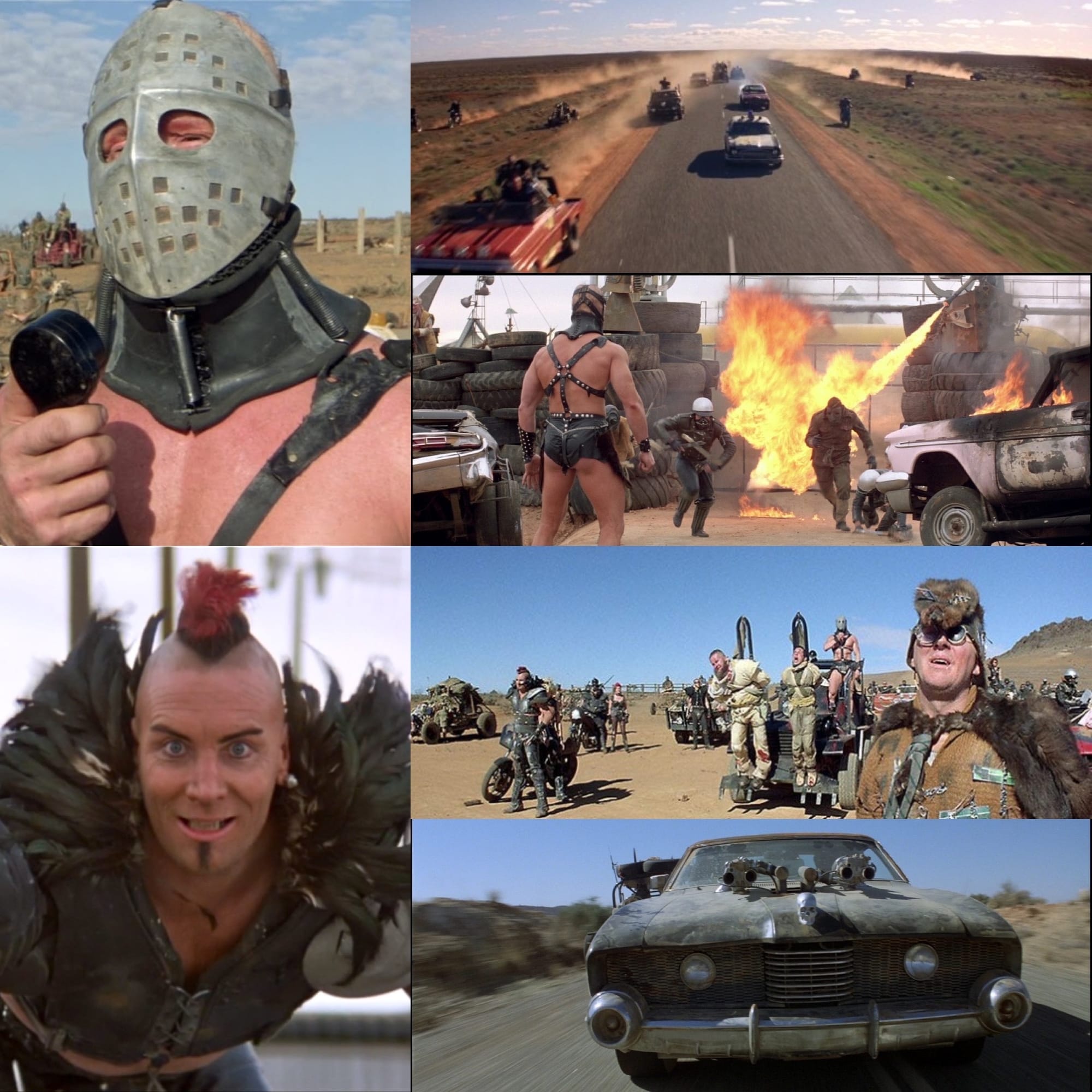
One of the all-time best action movies ever made, The Roadwarrior is the bigger, faster, and louder sequel to the film, Mad Max. It was originally called Mad Max 2 in Australia, but for the American release, the title was changed, as the first film was much less-known in the States. In fact, in the early days of the Home Video market, the VHS release of Mad Max was emblazoned with a legend describing it as “the thrilling predecessor to The Roadwarrior.”
I first saw this film the whole way through one summer day on HBO, probably around '84 or so. I remember feeling like I had seen it before, which maybe I had, or maybe the film’s themes were just that familiar, but either way, I loved it, and watched it multiple times that summer. This film not only then led me to a slew of other “Wasteland Warrior” and “Post-Apocalyptic Road War” movies, something the 1980s were more than happy to supply me with in a seemingly endless amount—She-Wolves of the Wasteland, Cherry 2000, Warriors of the Wasteland, A Boy and his Dog, Omega Man, Damnation Alley, Escape from New York, Cyborg, The Blood of Heroes, or Hell Comes to Frogtown—it also led me to a lot of the late era deconstructionist Westerns of the 60s and 70s that I love, both spaghetti and otherwise–The Wild Bunch, Jeremiah Johnson, The Long Riders, Pat Garrett and Billy the Kid, the Outlaw Josey Wales, Little Big Man, Butch Cassidy and the Sundance Kid, The Good The Bad and The Ugly–films where all those classic blacks and whites bled into shades of gray.
I talked a lot about this franchise in my Furiosa review. My main focus there was mostly about what made Mad Max a great franchise, so if you’re interested in that aspect, that’s where you’ll find it.
Here, since I’m specifically talking about The Roadwarrior, I wanted to talk more about how, despite being the second film in the franchise, it stands completely on its own. As a story, it’s all one single piece, a perfect introduction, completely self-contained, where you're told everything you need to know, in what is otherwise a straight-forward retelling of the classic story of the Man With No Name, blowing into town, righting some wrongs, and then moving on.
When Miller started to become interested in the idea of returning to the world of Mad Max, he wanted a larger budget, enough money to allow him to be more ambitious, to truly realize his dream, which is something I think its fair to say he has been chasing ever since. Those ideas were inspired by that now classic mix of Campbell’s Monomyth, Jung’s concept of the Collective Unconscious, and the films of Akira Kurosawa, of course. The result is a bare bones plot, a story of simple and pure concepts, but that simplicity is what makes the film great. Gray ribbons of highway running across a sun-bleached emptiness to a brittle blue horizon. The man with no name and fewer words. Homesteaders beset by savages.
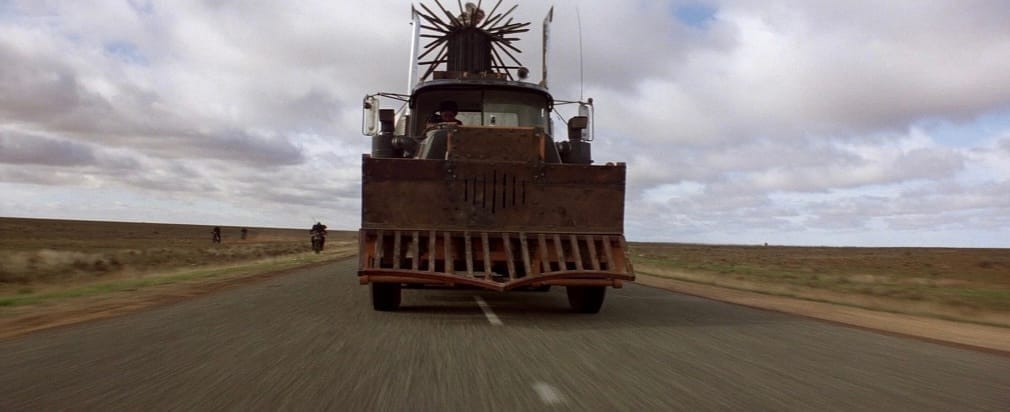
But in the end, it's just the truck and the road.
Here, the post-apocalyptic gladiators joust and parry at breakneck speeds. They leap between the various vehicles as they race down the highway. They crash and tumble in a storm of desert dust. They clutch their chests, and fall to the road like a cowboy catching a bullet at the cliff’s edge, to be crushed beneath the relentless roll of the tires. It is a simply spectacular sequence, true “let’s shoot this motherfucker” filmmaking, all practical effects and stunts, with tons of preparation beforehand, a little bit of daring-do, and a whole lotta prayers for good luck.
Much like Raiders of the Lost Ark, or the chase through Brooklyn in The French Connection, or through San Francisco in Bullitt, or Paris in The Bourne Identity, or the backroads of Texas in Death Proof, or the streets of L.A. in Drive, or heading eastbound and down from Texarkana to Atlanta in Smokey and the Bandit, the final chase in the Roadwarrior is one of the great car chases on film.
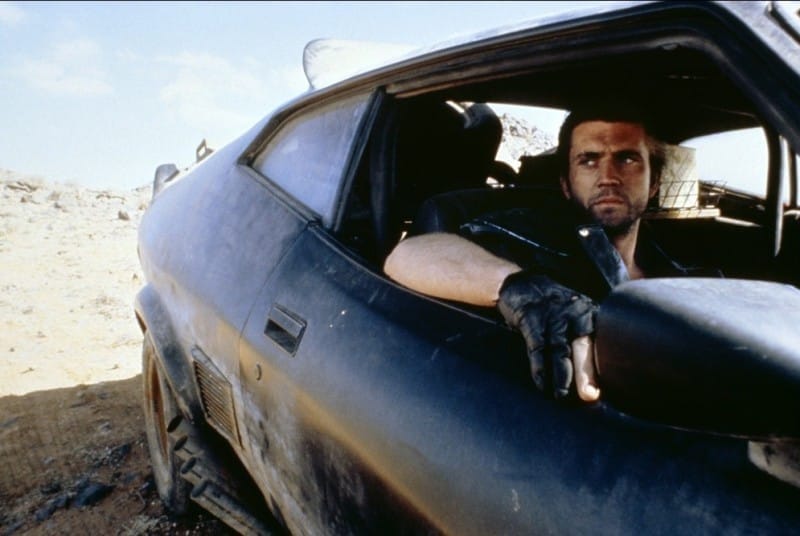
So, the story begins…
My life fades. The vision dims. All that remains are memories. I remember a time of chaos... ruined dreams... this wasted land. But most of all, I remember The Road Warrior. The man we called "Max."
To understand who he was, you have to go back to another time, to when the world was powered by the black fuel, and the desert sprouted great cities of pipe and steel. Gone now. Swept away. For reasons that are long forgotten, two mighty warrior tribes went to war, and touched off a blaze which engulfed them all. Without fuel they were nothing. They'd built a house of straw. The thundering machines sputtered and stopped. Their leaders talked and talked and talked. But nothing could stem the avalanche. Their world crumbled. The cities exploded. A whirlwind of looting, a firestorm of fear.
Men began to feed on men.
On the roads it was a white line nightmare. Only those mobile enough to scavenge, brutal enough to pillage, would survive. The gangs took over the highways, ready to wage war for a tank of juice.
And it was in this maelstrom of decay that ordinary men were battered and smashed... men like Max... the warrior Max. In the roar of an engine, he lost everything, and became a shell of a man, a burnt-out, desolate man, a man haunted by the demons of his past, a man who wandered out into the wasteland. And it was here, in this blighted place, that he learned to live again.
— The Chief of the Great Northern Tribe
It’s kind of uncomfortable reading that now, and seeing how this has become much more “Cassandrian” in the past few years, huh?
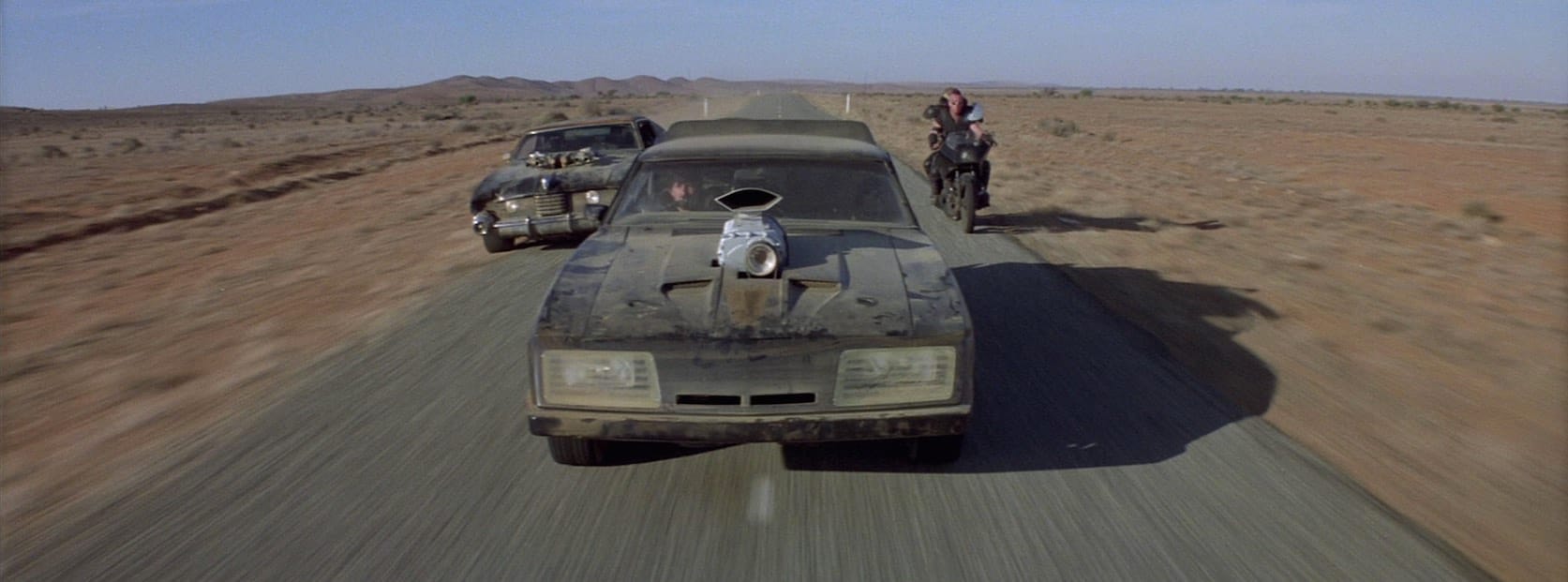
Anyway…
After a global war of some kind results in widespread oil shortages and ecocide, civilization collapses, and the world descends into barbarism. Former policeman Max Rockatansky, haunted by the death of his family, drives around the desert of what was once Australia, along with his dog, scavenging for food and petrol. Along the way, he battles fellow scavengers and marauders, using his superior driving skills and the threat of his double-barreled sawed-off shotgun.
When Max tries collecting gas at an apparently abandoned gyrocopter, he is ambushed by the Gyro Captain. Max overpowers the man, with his dog's help, and then spares his life when the Gyro Captain tells him of a working oil refinery nearby. When Max reaches the place, he finds a small refinery encircled by a marauders, and watches as several vehicles from the refinery try and fail to bust through the blockade. Leaving the Gyro Captain behind in chains, Max takes this opportunity to rescue one of them and offers to take them back to the refinery in exchange for gas. The place is full of weirdos and weaklings, all of them dressed in white, either flowing linens, or football pads and headbands. There’s also a Feral Kid, with Hair-Metal style and a razor sharp boomerang, who thinks Max is just the most awesome guy he’s ever seen. Unfortunately for Max, the guy he brought back dies almost immediately, and the leader of the refinery, a man named Pappagallo, refuses to honor Max’s deal.
The refinery people are focused on taking their gas and themselves, and then driving out of the Wasteland for the obvious pipe-dream of the distant coastline, which they are convinced is still a paradise. Pipe-dream or not, this dream is all they have, and the reason why some of their people tried out to bust through the blockade is because they need a vehicle to haul their gas. They’re about to take Max's car to aid in their efforts, and cast him back out into the Wasteland, when the leader of the Marauders addresses them over bullhorn from the surrounding horde. He is a huge, mostly naked guy with radiation burns, and wearing a hockey mask, who calls himself the Lord Humungus. He offers to spare all of their lives if they just walk away from the refinery.
The refinery people argue whether or not they can trust Humungus, and that’s when Max offers his own deal: “Two days ago, I saw a vehicle that would haul that tanker. You want to get out of here? You talk to me.”
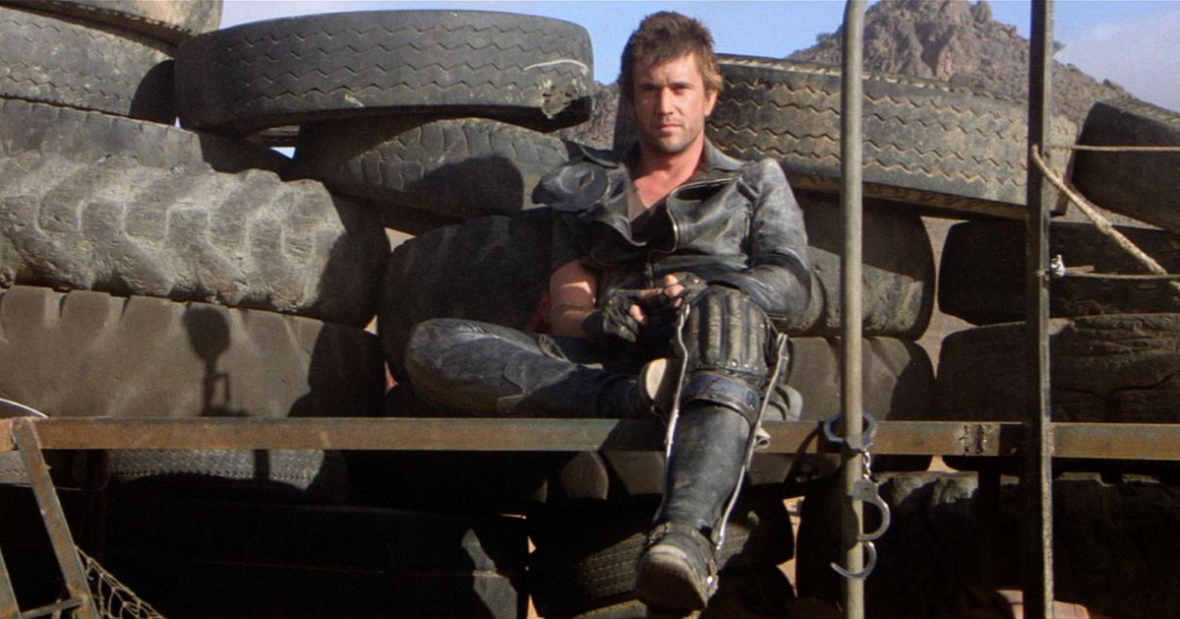
Max’s promises to bring them a semi-truck he saw earlier, if they return his car and give him as much fuel as he can carry. Sneaking past the marauders on foot, Max finds the Gyro Captain where he left him, and forces the man to fly him to the truck. Together, semi truck and gyrocopter punch through the barricade, which upsets the Lord Humungus, who puts on a torture-rave with the refinery captives that night.
Pappagallo tries one last pitch to get Max to drive the tanker truck, but Max refuses. “Not my problem,” he says, preferring to stick to their deal. He brought them the truck, now he gets his gas, and then he’ll leave. Pappagallo says:
“What is it with you, huh? What are you looking for? C'mon, Max, everybody's looking for something. You're happy out there, are you? Eh? Wandering? One day blurring into another? You're a scavenger, Max. You're a maggot. Did you know that? You're living off the corpse of the old world. Tell me your story, Max. C'mon. Tell me your story. What burned you out, huh? Kill one man too many? See too many people die? Lose some family? …Oh, so that's it, huh, you lost your family? That makes you special or something, does it?”
This moment is important because it highlights the selfishness of Max’s life. It highlights how Max is really just the same as Humungus and his horde, all of them using the tragedy that is their lives as an excuse to hurt others, and all while also highlighting that this does not make them unique in this world, that Max and the others have just chosen to live this way, that it’s a reflection of their soul. He’s shaming Max into seeing the monster that he has become, and imploring Max to rediscover his own humanity, the man he once used to be.
But Max refuses.
On the road, the marauders catch up to Max. He wrecks. His car is destroyed. His dog is killed. And the Checkov’s bomb attached to his gas tank finally goes off. Left for dead, Max is barely aware as he is rescued by the Gyro Captain and flown back to the refinery. When he awakens, despite his injuries, he insists on driving the semi truck, and Pappagallo agrees.
The plan is to send two separate groups of vehicles from the refinery. The first group is the heavily-armed rig, along with a fast car or two to run protection. Then a convoy of cars, including a school bus carrying the members of the community, will leave second, with the idea that the marauders will only care about the tanker, and the two groups will eventually rendezvous, if they can.
When everyone is out, they blow up the refinery.
Then the chase is on, and in the end, the refinery warriors, including Pappagallo, are all dead, as is the majority of the marauders, including Humungus, but Max rolls the semi in the process. It’s at this point that it becomes clear that the tanker is full of sand. The gas was hidden in barrels in the other convoy.
Max is left standing in the wreckage.
In time, it’s said that the Gyro Captain becomes the leader of the refinery people, and is eventually succeeded by the Feral Kid, who becomes the Chief of the Great Northern Tribe as a grown man. He then reveals in the voice-over, as we watch the warrior Max, the legend Max, be obscured in smoke and darkness, that he and his people never saw the Roadwarrior again.
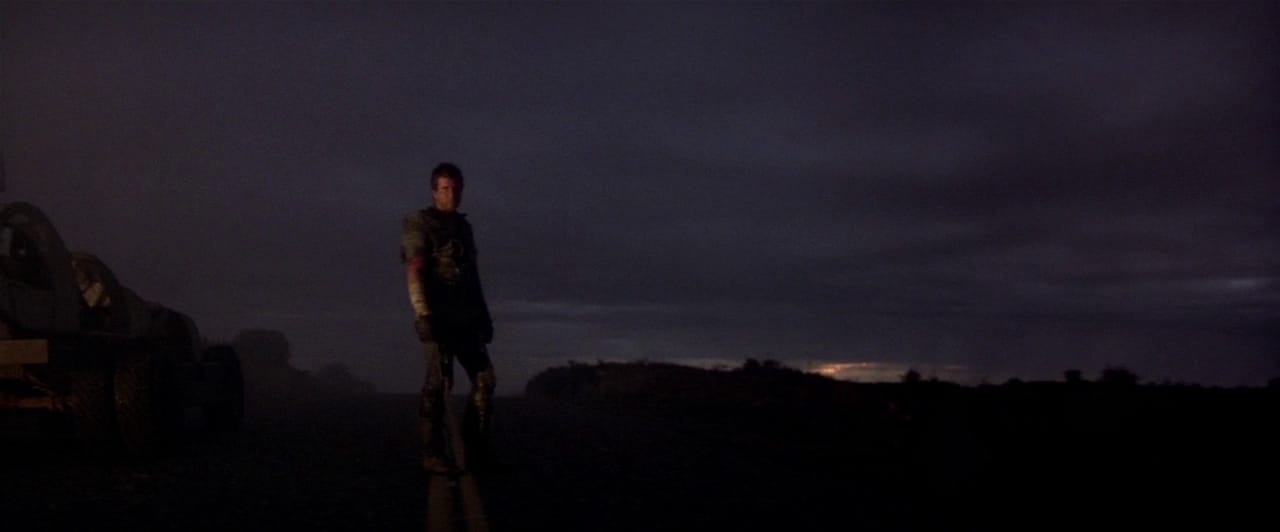
A fantastic ending.
But here’s the big question: Did Max know that he was a decoy? Did Max assume he could drive the semi through Humungus’ horde, or did he know it was a suicide decoy mission?
It could be read either way, I think.
On one hand, Max is obviously spoiling for a fight at this point. Maybe he simply assumed he could muscle it through, relying on his oft-proven ability behind the wheel? Besides, maybe he figured that driving this truck for these people would be the best chance for him to fuck-up Humungus and his horde, which is really what Max wants most of all, because he’s understandably angry after the marauders blew up his car and killed his dog. His name is MAD Max, after all.
Maybe Pappagallo was relying on that?
If you watch the refinery people's reactions when Max demands to drive the semi, they hesitate and exchange glances. To me, it doesn’t seem like their hesitation is them trying to play him. It doesn’t seem like smug satisfaction upon him offering to do exactly what they were trying to manipulate him into doing all along. It's more like an unspoken question passing between them, like a moment where they all check in with each other, “Do we do this?” Because, yes, Max is an outsider, and a kind of opportunistic prick at that too, one who hasn’t quite proven to be all that trustworthy unless he benefits, but still… they’re decent enough people that at the same time, they’re all aware that they’re using him, and that making him into an unwitting decoy is pretty shitty.
BUT… they’re doing this for the greater good of their community, and like I said, Max IS an outsider, not one of them, and they don’t know that they can trust him with the truth of their plan, and everything is relying on that truth working out. So yeah, to me, that hesitation was them silently weighing the cost of their own souls against the cost of their own lives, and ultimately deciding that it’s okay, and yes, Max should drive the truck.
Maybe that’s why the folks who join Max on the truck do so. Maybe that’s why Pappagallo drives protection next to the semi. Maybe they’re just paying the price for their intentional sacrificing of Max, absolving the others of their sins, so that they can then enter paradise?
Maybe?
Or maybe their plan was, once Max drives the semi through the maruaders to safety, and all of that is handled, and before they then rendevous with the rest of the community... they kill him. Shoot him in the back, and dump him along the road. After all, he's a scavenger, right, a maggot living off the corpse of the old world. They never had any intention of letting him into their paradise. You don't bring a vicious animal into your house.
We don't know, right? Honestly, the refinery people only get our sympathies because Humungus is attacking them, and because they wear white. Sure, they behave like civilized people, but there’s no reason to believe that they weren’t fully committed to betraying Max from the very beginning. It makes sense, they’re all helpless. They’re outgunned. They have a resource, and it’s brought wolves to their door, and they’re all alone, with no help coming. Or at least, no altruistic help, for even Max wants his share. This makes them wary and distrustful and ready to lash out. They know what will happen to them if they stay at the refinery, so if they want to survive, they have to fight their way out, and that means spilling blood.
Plus, the refinery people obviously have no intention of sharing their gas, not with anyone, and certainly not with the trash out there on the road. They consider all of those people to be enemies. This is why they would be willing to betray Max. He's not one of their group. This is also why they blow up the refinery when they leave. They didn’t have to do that. They could've just left it, right? Who cares? They're on their way to paradise, right? But nope, they blow it up. The reason why is simple. It was theirs, and they didn’t want anyone else to have it. Not even when they were done with it. Not even when they were gone and didn't want or need it anymore.
There’s an ugly privilege in that.
And it's accompanied by the question of what their world might have looked like had they extended an open hand to the world around them, rather than a closed fist. I’m not claiming Humungus was a misunderstood nice guy or anything, just that the refinery people obviously felt powerless, beset on all sides, and for good reason, and this made them afraid and angry, and as a result, they hate the world for making them feel this way. It's not a big step to create a very simple, very vicious "us aginst the evil world" point of view.
This shouldn't be surprising at all, it's basically one of the driving factors of the conservative movement in modern day American politics, although in that case the fears that movement is based on are all a bunch of ignorant, racist, and xenophobic nonsense, not to mention naked hate, but still, the point is, their victimhood leads to entitlement, it leads to greed, to anger, and a willingness to hurt. The refinery community's whole worldview is clearly shown when Pappagallo confronts Max: “You're a scavenger, Max. You're a maggot. Did you know that? You're living off the corpse of the old world.” There’s acid there when he says that, and to me, it's the most revealing moment of their motivation.
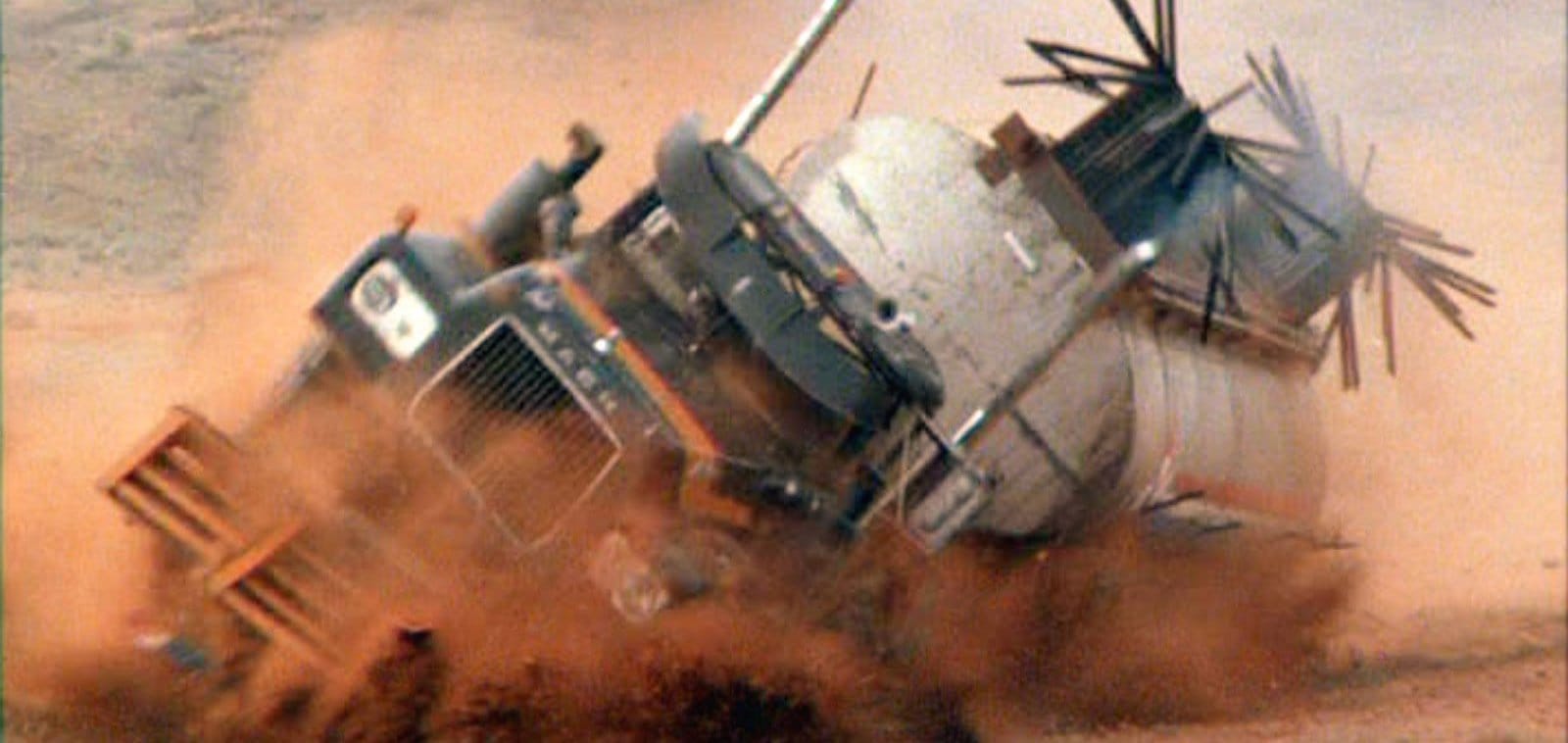
OR…
Is Max still just trying to die like he was at the beginning of the film?
After all, at this point, Max has lost everything that was connected to his old life, his car, and whatever was inside it, being that last piece. He even lost his dog. Plus, Max isn’t stupid, he had to have seen them loading the barrels into the bus. Really, the plan is obvious enough that Max should’ve guessed it, right? It’s possible that he did. Maybe he knew, but he didn’t actually know. Maybe Pappagallo didn’t tell him, and Max didn’t care. Maybe he was more interested in the fight than the goal. Maybe he was just looking for his end, and once again was unable to find it, and so he was left to alone, the Roadwarrior, a man with no past and no future.
For me, the big tell is in the very ending.
Max is our viewpoint character, we’re always and only ever been with him, so we discover the sand in the tank when he does. If he'd known, there would’ve been an earlier reveal, the fact that it was a suicide run would’ve been the whole point of the scene, it would’ve been framed as a noble sacrifice. But what we get instead, is the truck spilling sand across Max‘s hand as he stares silently. We watch the last of the horde pull up, see the sand, turn and drive away. Everyone in the scene seems to be realizing they were played at the same moment, and more than anything, Max seems resigned.
But then, how could he complain? They used him, but he was using them too. When they do offer him a space in their community, he declines. "All I want is the gas." It was his choice from the very first moment they met. He was the one who insisted that their relationship be transactional, so when he said that he wanted to drive the truck, they let him. That this deal turned out to be full of sand is because it’s a worthless and empty way to live, which is befitting of a man with nothing, "a shell of a man, a burnt-out, desolate man, a man haunted by the demons of his past." So maybe the refinery was right in planning to betray Max, to keep him out of their community? After all, he is the man who keeps Mr. Death in his pocket.
Because the whole point of the Road Warrior isn’t just a classic Man With No Name Western story, it’s all about exposing how hollow these post-apocalyptic power fantasies are. By using the classic Western set up, the gunslinger--or in this case the Roadwarrior--is shown to protect civilization, but also that he can never be a part of that civilization, for he is a monster himself, doomed to die either by the sword, or alone and unremarked.
Like the man himself, Yul Brynner, says in the film The Magnificent Seven—as the laconic Cajun gunslinger Chris Larabee Adams, the equivalent of Kambei Shimada in the film Seven Samurai: “The old man was right. Only the farmers won. We lost. We always lose.”
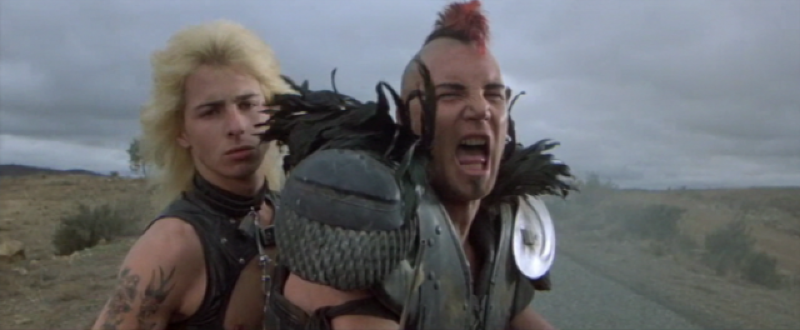
Whatever the answer, Mad Max 2 was a huge commercial success, grossing $10 million in Australia alone, which was double what the first film earned, making it one of the highest-grossing Australian films at the Australian box office. In the U.S., it grossed $23 million, also outperforming Mad Max, making it the majority of American viewers’ initial entry into Max’s world. With a worldwide total of $36 million, it became one of the highest-grossing Australian film worldwide.
In 2008, it was selected by Empire magazine as one of the 500 Greatest Movies of All Time. The New York Times placed the film on its Best 1000 Movies Ever list. Entertainment Weekly ranked it 93rd on its list of the 100 Greatest Movies of All Time in 1999 and 41st on its updated list of the All-Time 100 Greatest Films in 2013, and ranked Mad Max himself 11th on its list of the All Time Coolest Heroes in Pop Culture. In 2016, Playboy magazine ranked the film 11th on a list of 15 Sequels That Are Way Better Than the Originals.
All of that is either super-important to you, or complete nonsense, so all that shit aside, it’s simply a blast. A fantastic and fun high-energy good time of a film. It’s one of my all-time favorites, and that’s why it’s the 4th entry on my list of 20 most influential films of all time.
If you haven’t seen it, you should definitely check it out.
